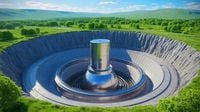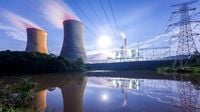In the world of energy innovation, few technologies have generated as much excitement—and as many tough questions—as microreactors. These tiny but mighty nuclear reactors, each capable of producing under 20 megawatts of power, are small enough to be shipped on the back of a truck yet powerful enough to light up an entire town. As the world’s appetite for reliable, clean electricity grows—driven by everything from remote Alaskan communities to the relentless demands of AI data centers—microreactors are increasingly being seen as a potential game-changer. But their journey from concept to commercial use is anything but straightforward.
According to The Conversation, microreactors offer a striking contrast to the behemoth nuclear plants most people picture. Instead of sprawling facilities covering hundreds of acres, a microreactor could sit comfortably on land the size of a football field. Their potential applications are as varied as they are ambitious: powering isolated villages, providing steady electricity for universities, supporting mines and industrial operations, and even serving as a secure energy source for military bases. The flexibility and portability of these reactors make them uniquely suited for off-grid and remote locations, where traditional power infrastructure is either unreliable or prohibitively expensive.
One company leading the microreactor charge is Oklo, which has become a darling of the stock market—even if its financials haven’t quite caught up to the hype. As reported by The Motley Fool, Oklo’s stock has soared more than 900% over the past year, despite the company not having generated any revenue yet. Its main product, the Aurora microreactor, produces just 1.5 megawatts of electric power per unit—a far cry from the 1,000 megawatts generated by traditional nuclear reactors. However, Oklo’s design allows these units to be chained together, potentially delivering between 15 and 100 megawatts of power, making them well-suited for remote or off-grid systems.
What sets Oklo’s technology apart isn’t just its size. The Aurora uses metallic uranium fuel pellets, which are denser, more resistant to high temperatures, and cheaper to fabricate than the uranium dioxide pellets used in conventional reactors. Even more impressively, these fuel pellets can be recycled in a closed loop for about a decade without needing to be refueled—a significant improvement over traditional reactors, which require refueling every two years. Oklo began working with the U.S. Nuclear Regulatory Commission (NRC) in 2016 and received Department of Energy approval to build its first reactor in Idaho in 2019.
Yet, despite all this promise, Oklo’s path to profitability is still littered with obstacles. The company doesn’t expect to generate any revenue until it deploys its first microreactors in Idaho in late 2027. Analysts predict steep net losses of $64 million in 2025 and $76 million in 2026, with only $13 million in revenue and a $73 million net loss forecasted for 2027. As of its latest quarter, Oklo had $90 million in cash and equivalents and a low debt-to-equity ratio of 0.1, giving it some breathing room to raise additional funds if needed. But with a current market capitalization of $11.7 billion, Oklo is trading at a valuation that would make even the most optimistic investor pause—899 times its projected 2027 sales, according to The Motley Fool.
Beyond the financial tightrope, the microreactor industry faces a classic catch-22 when it comes to manufacturing. As The Conversation explains, while microreactors could theoretically be factory-built and deployed rapidly, setting up those manufacturing facilities requires enormous upfront investment. Developers are understandably hesitant to build factories without confirmed orders, while potential buyers are waiting to see proven production and reliable cost estimates before placing those orders. It’s a standoff that government funding and early adopters—such as national laboratories, universities, and military bases—could help to break by validating the technology and its economics.
Safety and public trust are also front and center in the microreactor conversation. The simple designs of these reactors—often featuring few or no moving parts—reduce points of failure and make them easier to regulate. In fact, microreactors are so much simpler than their large-scale cousins that emergency planning zones could be significantly reduced. While traditional nuclear plants require a 10-mile emergency zone with detailed evacuation plans and a 50-mile zone for food and water precautions, microreactors might only need a safety buffer extending to the facility’s site boundary, or a few hundred meters beyond. This opens the door to siting microreactors much closer to where people live and work.
But technical feasibility is only half the battle. As Aditi Verma, Assistant Professor of Nuclear Engineering and Radiological Sciences at the University of Michigan, told The Conversation, community acceptance will depend on how developers engage with local residents. "If they attempt to unilaterally decide, announce and defend their decision to build a microreactor without input, communities will likely push back," Verma noted. Her research team found that when developers work with communities to understand their hopes, concerns, and priorities, many people are open to the idea of hyperlocal nuclear energy. In southeast Michigan, for example, residents suggested integrating shared spaces, recreational facilities, visitor centers, and public art into microreactor sites—transforming them from hidden infrastructure into community assets.
Despite their potential, microreactors are not yet ready for commercial deployment. The Department of Energy currently oversees demonstration projects, but commercial rollout requires approval from the NRC, a process that could take several years. Several designs are now approaching or in the early stages of regulatory review, but the timeline for widespread adoption remains uncertain.
Meanwhile, the broader market for microreactors looks set for explosive growth. Zion Market Research projects a compound annual growth rate of 19.1% for the global microreactor market from 2025 to 2034, fueled by population growth, the shift toward green energy, and the energy demands of cloud and AI technologies. Yet, as The Motley Fool cautions, even if Oklo executes flawlessly and grows its revenue at a robust 20% annual rate, its current valuation leaves little room for error. That’s likely why company insiders have been net sellers over the past year, even as the stock price has soared.
For now, microreactors remain a technology on the cusp—brimming with promise, but still facing significant technical, financial, and social hurdles. Whether they ultimately transform the energy landscape will depend as much on community trust and regulatory approval as on engineering breakthroughs and market enthusiasm.

